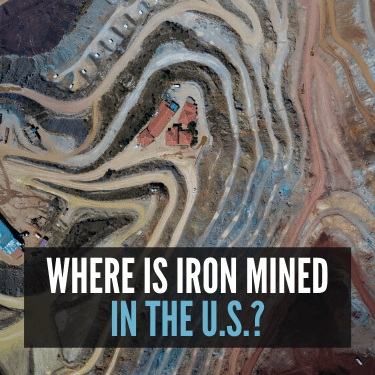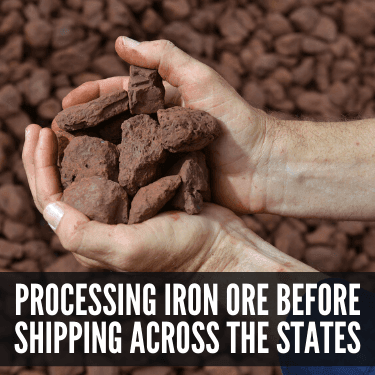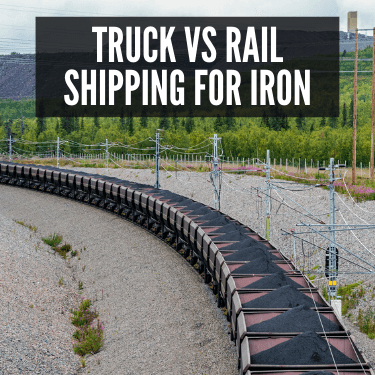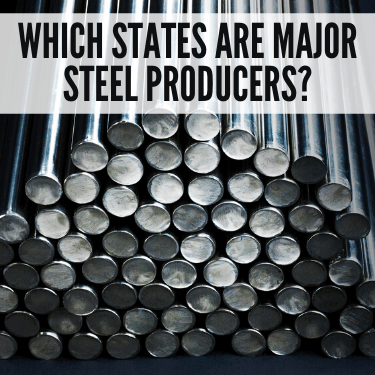If you’re in Michigan or Minnesota and mining valuable minerals, there’s a chance you have a vested interest in the iron ore transportation process. In the area around Lake Superior, it is a huge industry but one where the production still needs to go elsewhere to be turned into steel.
Learning more about iron ore transportation and how it can help your operations reach their financial goals is invaluable. In the iron ore trade, you’ll need to be concerned with the raw material being transported multiple times before it’s turned into usable steel. Read more below about how to handle this.
Also, consider partnering with a reputable third-party logistics (3PL) company like R+L Global Logistics. Finding a good fit to take over the hauling of your raw iron ore can make a huge difference, both in the way your business is able to run and also on the money side of things.

The state of Minnesota leads the country in iron ore production by a wide margin. In fact, 98 percent of the iron ore mined in America in 2018 came from the Lake Superior region of both Minnesota and Michigan. Even so, Minnesota does the vast majority of that 98 percent.
Learn more about freight shipping from Minnesota to Michigan.
There are three major iron ranges in the Land of 1,000 Lakes, with the Mesabi Range being the biggest producer of iron ore. The other two are the Cuyuna and the Vermilion.
Besides these two U.S. behemoths, there is not any other substantial iron ore production in the country. While that wasn’t always the case — think Birmingham, Alabama in the 20th century — it is currently. Since iron is not a renewable resource, once a place has been stripped of its iron ore, it is done for good.
Other than the Michigan and Minnesota area, the most recent operating iron mine was in Utah. However, that mine closed down in 2014.
First, it is important to know there are two kinds of mining for iron:
It is important to make the distinction between the two because each utilizes a different type of transportation to get it to the processing plants.
In surface mining, once iron ore is extracted from the Earth’s crust, it is loaded into dump trucks that have a high loading capacity to be taken to the processing plants.
With underground mining, there are a variety of different ways to transfer the metal. The resource is hoisted to the surface up a shaft and shipped to processing plants in myriad ways. First the ore is loaded onto trains that take it to Lake Superior, where it is then put onto ships. The reason ships are used is because no taconite mine in the U.S. is located more than 100 miles from the Great Lakes and shipping by boat is considered a low-cost mode of transport.
A less common method of iron ore movement during this phase is the use of a slurry pipeline. This is a special kind of pipeline that is a mixture of iron ore and water that moves over a long distance. Once the slurry gets to the processing plant, the water is drained and the ore is then ready for processing.

Before it reaches steel mills, iron ore is not always shipped in giant, raw chunks. A large portion of the iron ore we get now comes from taconite, which is a type of iron formation that also contains other minerals like quartz, carbonate or chert. Even iron that is “pure” is never truly pure and needs at least a base level of beneficiation
Iron usually comprises 25 percent of taconite, so it needs to be heavily processed before it reaches steel mills. Both to separate the iron from the other minerals but to shape it in a way for the steel-making process to be able to properly use it.
This is the point where the taconite is shaped into pellets, which satisfies both of those requirements. The beneficiation process removes impurities in the ore and improves the quality. In this case, the iron ore is agglomerated into pellets, which is the most common form that iron is introduced to steel-making blast furnaces.
The reason agglomeration is preferred to other methods is makes the ore permeable so that gases during the transformation into steel can pass through the pellets. There are three types of agglomeration, the one used in this case is called pelletizing.
Pelletizing sees the taconite ground into a fine power and then heated up to form marble-sized balls. Binders are then added to make sure the newly formed pellet retains its shape during shipping and at the steel mills.
Iron and steel aren't the only metals on the move. Learn how to ship precious metals.
Once the iron ore is processed correctly, it can then be sent to the mills to be turned into steel. Once this is ready to happen, there are a number of shipping methods to make that happen.
Truck: Loading your iron ore onto a tractor trailer is a good all-around mode of transportation since it can reach any part of the continental United States with little issue. The freight hauling industry strikes the perfect balance between ubiquity and affordability that other modes of transportation would be hard-pressed to match.
Most businesses have knowledge of loading and unloading a truck, so there’s no hang ups there.
Rail: Shipping by rail has seen an uptick in recent years since it is viewed as a sometimes cheaper, always cleaner and readily available form of transport. This involves your items going onto into a shipping container and being loaded onto the train platform.
Ship: In the United States, since so much of the currently mined iron ore is located near one of the Great Lakes, there is a huge incentive to use ships for at least part of the journey from the mine or pit to the steel mills. Part of this, besides the convenience, is the inexpensive cost relative to the same trip taking place via truck or rail.
Having said that, there’s a better than average chance that shipping by boat alone will not be able to complete the trip, so it will be used in conjunction with truck or rail to some degree.
Pipeline: As described earlier, a slurry pipeline is one that transports a mix of iron ore and water over long distances. It is not used as a primary shipping method by itself and it most likely will run to a body of water to be loaded onto a ship to complete its journey to the steel mill.
A downside to this method is that pipelines are susceptible to rupturing, which can completely shut down the movement of iron ore temporarily while the pipeline is fixed, or permanently if it is a bad enough incident or the pipeline has been problematic multiple times.
Intermodal: This refers to the use of two or more of the above transportation types. This is becoming more popular each year since many shipments cannot be completed via just one mode of hauling.

Truck shipping and rail shipping each have their own distinct strengths and weaknesses. It is important to analyze both and decide what will be the appropriate one for your particular needs.
A truck shipment can get the iron ore directly to the steel mill. Unless train tracks go right to the mill, you’d still need some other way to get them the rest of the way.
Also, you have a dedicated driver for your load if you have an entire truckload. This means there won’t be a bunch of stops along the way and possible delays.
This can be listed as a pro or con since it is dependent solely on the market rate but when the price of diesel is down, the cost of shipping via truck is then lower than that of shipping by rail.
A trucking company can also offer expedited shipping for times when you need something there earlier than usual. While you may have to pay an additional fee for this, it’s at least an option for times when you find yourself in a bind. With a train that is carrying the loads of other customers, the rail choice can’t offer such a service.
Fuel efficiency is probably the biggest drawback to shipping by truck. A train is always going to be more fuel efficient than a truck and depending on the market price for diesel fuel at a given moment, it can also be more expensive to ship by truck than rail.
There are also times when, for a variety of reasons, it might be hard to find a truckload. There might be less drivers available for instance, which will also make it harder (and more expensive) to find an empty tractor-trailer to ship in.
Rail shipping can ship more at a time than a single truck can. Yes, you’ll have to pay for the number of cars used on a train but you don’t have to worry about multiple trucks carrying multiple loads at possibly different times. Your loads on the rails will also show up at the same time. Many times, containers can also be double stacked as well. While this doesn’t reduce the weight, it allows a train to haul more freight in a space of the same length and width — something a truck can’t compete with.
Rail shipping doesn’t have to worry as much about closures, traffic or other outside forces as traditional road vehicles do. Also, trains are more fuel efficient than trucks. Not only is that better for the environment, but since less fuel is being burned, it should lead to savings for you, the customer.
In truth, most loads shipped by rail — especially over longer distances — will end up using trucks for some portion of the journey. Train tracks rarely have a stop right at a business, meaning the load will have to be shifted to a truck or boat at the beginning and end of each trip.
This is referred to as intermodal transportation, where containers or loads are sent between two points using more than one type of transportation, whether it be trucks, planes, trains or ships. This type of moving freight has grown because it is more efficient than solely trucks in the U.S. and impossible to use just one mode of transport when shipping overseas.
While it can be seen as a positive overall, intermodal transportation is not a pro for shipping entirely by rail. A truck can make a delivery from point A to point B by itself in nearly every domestic case, but a train cannot do that same.
Overweight or oversized trucking shipments are only allowed for items that have to be shipped in one piece. Since a load of iron can be easily separated, an overweight load would be unnecessary — and also illegal.
The definition of an overweight load is one where the total weight of the vehicle is in excess of 80,000 pounds. The only way a load is allowed to be shipped as overweight would be if it is not able to be divided.
So if you have enough iron ore to fill more than one truck, that will have to be factored into your shipping costs and plans.

Once the world’s largest producer of steel, the United States’ production has waned from its peak in the 1950s. Still, America is the fourth-largest producer of steel behind China, India and Japan and ahead of South Korea and Russia.
Much of the U.S. steel production is kept in the country to feed the construction and automobile industries but how does that iron ore get turned into the hardened metal needed to keep building?
Once the taconite pellets are processed, they are shipped to steel companies to make steel products. There are three states that can call themselves major steel producers:
Of the nine currently operating integrated steel mills, five are in Indiana, one is in Pennsylvania and two are in Ohio. The three companies that run those nine mills are AK Steel, ArcelorMittal and US Steel.
There are also over 100 minimills (or speciality mills) that make up 59 percent of America’s steel production. Two of the more notable specialty mills are located in the Keystone State.
Once the iron ore is transformed into steel, it can be used to build a variety of products in different industries. The two biggest ones are the construction industry and the transportation industry — which includes cars, airplanes, railroads and trains.
But in actuality, the use of steel extends into many facets of life as it’s used in the energy field as well as modern appliances like refrigerators, washer and dryer machines, dishwashers, sinks and more.
Just focusing on construction and the transportation industry, since it needs a lot of steel to make its products, let’s break down how it would be moved. As mentioned previously, steel is able to be divided, so it can be transported by any available means of transport. That could be by truck, train or boat, and your operation will have to figure out which one to use depending on its convenience, reliability and cost.
Automobile manufacturers will be a relatively easy business to deliver to since they’re highly likely to have the facilities to receive large shipments of steel for either immediate use or storage. The same goes for the aviation industry.
Construction sites, on the other hand, are all different and out in the open. Delivering steel to them comes with a different set of potential dangers since construction sites are active places with workers constantly moving around. While you want an experienced company for any of your deliveries, you especially want one when having to deliver to construction sites.
Luckily for you, R+L Global Logistics has the aptitude and real-life knowledge to competently and safely deliver to construction sites without any problems.
Once the iron ore transportation process has become clear to you and you’re ready to ship, look to do so with the trusted 3PL company R+L Global Logistics. We can easily, efficiently and quickly ship your unprocessed ore to the steel mills to have them turned into a strong, durable product.
With our 99.5 percent on-time rate and industry-leading customer service, R+L Global Logistics is well positioned to be both speedy and helpful during the entire course of shipping your load. Also included with each of our trucks is real-time freight visibility so you can track your minerals’ journey from start to finish.
When the regular timeframe simply won’t do for your business needs, R+L Global Logistics can offer expedited shipping at an additional cost. This can drop the turnaround time by a day or two in most cases.
So when you’re prepared to engage in iron ore transportation or even ship refrigerated freight like cranberries, check out the heavy haul trucking competitive pricing at R+L Global Logistics. For a free freight shipping quote today with no obligation, call us at (866) 353-7178.
R+L Global Logistics
315 NE 14th St., Ocala, FL 34470